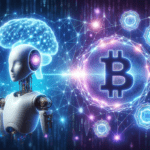Blockchain 4.0
Introduction to Blockchain 4.0 has emerged as an evolutionary step which has enabled faster, more secure and easy to use blockchain technology. As compared to Blockchain 3.0, Blockchain 4.0 is a more mature form of blockchain technology that decentralizes and enables data transactions at much faster rate. It introduces various core objectives like High-Speed Transactions, Improved User Experience, and Advanced Usability which act as the building blocks for development and adoption of decentralized services. Decentralization has become the cornerstone of blockchain4.0 which makes it easier and faster to send and receive data and money. The use of blockchain4.0 has allowed for greater transparency and security, while also allowing for faster and more efficient transactions.
| Feature/Version | Blockchain 1.0 | Blockchain 2.0 | Blockchain 3.0 | Blockchain 4.0 |
|---|---|---|---|---|
| Main Focus | Cryptocurrency and Decentralization | Smart Contracts | Scalability and Inter-blockchain Communication | Scalability, Interoperability, Security, Privacy, Governance, and Consensus Mechanisms |
| Key Innovations |
- Peer-to-peer Transactions - Blockchain Core for Cryptocurrency |
- Ethereum Platform - Open-sourced Smart Contracts - DeFi, DAOs, ICOs, NFTs |
- Introduction of Cardano (ADA) - Reduction of High Gas Fees - Enhanced Security Features |
- Advanced cryptographic techniques - Zero-knowledge proofs - Privacy-preserving protocols |
| Applications | Financial Transactions | Decentralized Applications |
- Supply Chains, Cybersecurity, Voting, Healthcare, Web Services - IoT |
- Enhanced Smart Contracts - Tokenization and Digital Assets |
| Scalability | Limited | Moderate | Improved | High (through sharding, state channels, or layer two solutions) |
| Interoperability | No | Limited | Limited | High (between different blockchain networks and protocols) |
| Security and Privacy | High (Anonymized Transactions) | Moderate | Enhanced | Advanced (through advanced cryptographic techniques and privacy-preserving protocols) |
| Governance | Not Applicable | Not Applicable | Not Applicable | Innovative Governance Models and Consensus Mechanisms |
Web 3.0 and Metaverse: The New Frontiers
Web 3.0 and the Metaverse are emerging as the new frontiers of the Blockchain 4.0 revolution. At the heart of this technology lies distributed ledger technology (DLT) and cryptographic security, which together enable digital asset tokenization and a secure user experience. With DLT, users are now able to move digital assets globally in an incredibly efficient and secure manner.
Moreover, user experience is significantly improved due to the single ledger recording all the transactions, which requires much less effort and resources. The blockchain-based virtual world, known as the Metaverse, is also bridging the real and virtual worlds, allowing for a whole new layer of existence that is decentralized and secure. This creates an exciting environment for users, developers, and businesses alike, who are now able to leverage the power of the blockchain for a variety of novel applications.

Overcoming Past Hurdles
The past blockchain versions faced various obstacles in terms of processing speed and user experience. It has also been noted that usage of blockchain 3.0 was limited mostly to niche audiences. With the emergence of Web 3.0 and the Metaverse, there is potential to overcome these hurdles and strengthen user experience.
Smart contracts are becoming the norm in Web 3.0. They enable machine-to-machine transactions, which ensures faster and secure processing. Additionally, they also foster a more comprehensive user experience with blockchain technology. This could potentially allow a larger, more mainstream audience to gravitate towards blockchain 4.0 and the Metaverse.

Empowering Industries with Blockchain 4.0
Blockchain 4.0 represents a solution to the privacy and scalability problems that hindered the adoption of blockchain technology by various industries. This advanced version of blockchain technology can help businesses save costs, increase efficiency, and provide access to better customer experiences. With peer-to-peer transactions, businesses can reduce the need for intermediaries, while digital ownership makes sure that all processes are secure and reliable. Additionally, it has paved the way for blockchain developers to explore the evolution of decentralization.
The advantages offered by blockchain technology are far-reaching. Smart contracts can enable secure and faster transactions than conventional methods, while data can be securely stored and accessed on a decentralized ledger. The new blockchain can also help businesses to gain better visibility and insights into their supply chain operations, which can be useful for ensuring greater transparency, efficiency, and compliance. Furthermore, digital asset tokenization enables businesses to securely manage digital goods, providing greater control over ownership and asset circulation.
Decentralization and Distributed Governance
Blockchain 4.0 is revolutionizing the landscape of distributed ledger technologies, largely thanks to decentralization and distributed governance. With its novel consensus mechanisms, Blockchain 4.0 is making seismic changes to the traditional systems of authority, by enabling users to independently own their own data, assets, and experiences without relying on third-party intermediaries. In this way, Blockchain 4.0 is helping to shape the much-anticipated world of Web 3.0, while radically restructuring the existing models for peer-to-peer networks.
Not only is Blockchain 4.0 helping to power the Metaverse, its advancements in cryptographic security are providing greater trustworthiness to data transferred and stored on its network. These security measures are essential for providing assessments of risk and potential fraud prevention for users who wish to partake in financial transactions using the technology. Blockchain 4.0's suite of security protocols are becoming the foundation of secure value transfer.

Security Enhancements
Security enhancements play an important role in modern digital infrastructure. Blockchain 4.0 focuses heavily on providing a safe and secure platform for digital asset tokenization and value transfer. The Impact of Blockchain 4.0 on Digital Asset Tokenization focuses on the development of cryptographic unit of accounts, digital wallets and secure transactions.
Transitioning from Web 2.0 to Blockchain 4.0: A Digital Revolution strengthens the security protocol with distributed ledger technology, paving the way for secure credit and digital wallets. Exploring the Innovations Brought by Blockchain 4.0 further ensures the secure storage of digital assets and the immutability of transactions. By expanding the scope of secure transactions, Blockchain 4.0 revolutionizes digital asset tokenization.
Future Implications
The introduction of blockchain 4.0 means that smart contracts will become commonplace. It will enable smarter and more efficient peer-to-peer transactions, which will be secured by blockchain cryptography. This means that users will be able to conduct business without the need for a third-party intermediary, automatically transferring assets based on pre-defined conditions. Additionally, blockchain 4.0 will also enable users to embrace digital ownership, as it will allow them to use digital assets to tokenize tangible and intangible assets. This technology will revolutionize the way people store and transfer wealth, and will allow for greater liquidity in the market.

The new era of blockchain 4.0 has a wide range of potential implications. It could lead to more secure and efficient identity management systems, as well as more transparent and secure online payments. Blockchain 4.0 could also enable a wide range of industries, such as banking and government services, to benefit from this technology. Furthermore, its security capabilities could prevent malicious counterparts from carrying out fraud, and provide users with more control over their digital assets. All of these improvements would enhance the user experience, creating an improved digital landscape that would be both more secure and user friendly.
Case Study: Logistics 4.0 in the Agri-food Supply Chain
Background:
In a study published in 2023, a case was made for the integration of blockchain technology in the agri-food supply chain under the umbrella of Logistics 4.0. This initiative aimed to address challenges like traceability, transparency, and efficiency in the supply chain management of agri-food products.
Implementation:
Blockchain technology was employed to create a traceable, transparent, and efficient supply chain system. The real-time data captured on the blockchain enabled stakeholders like farmers, logistics providers, and consumers to have a clear view of the product's journey from farm to table.
Outcome:
The implementation of blockchain technology enhanced the traceability of products, ensured transparency in transactions, and improved overall efficiency in the supply chain management, aligning with the goals of Logistics 4.0.
This case showcases how blockchain technology, presumably with features aligned with Blockchain 4.0, was utilized to modernize the logistics in the agri-food supply chain, which is a part of the broader Industry 4.0 revolution. The terminologies may vary, but the core objectives of enhancing speed, user experience, and usability are common in both Logistics 4.0 and Blockchain 4.0, as seen in other discussions surrounding Blockchain 4.0 and Industry 4.0
Final thoughts
Blockchain 4.0 marks a major milestone in the decentralized ledger technology. By introducing core objectives of speed, user experience, and usability, it has enabled further innovation that could help bridge the real and virtual worlds, with enhanced security and verifiable ownership. This technology has the potential to revolutionize cross-industry operations, digitizing assets and creating a more secure transactional framework for money movement and payments. In the near future, we can expect continued development and improvement in the technology to achieve the goal of a world without intermediaries, and towards a truly decentralized digital economy.
What is the general conclusion of this paper?
This paper concludes that blockchain 4.0 is ushering in a new era of trust, transparency, and freedom. It has the potential to revolutionize existing industries and create new ones, through the power of decentralization and distributed governance. Security is another key component of Blockchain 4.0, and advancements in this area will ensure that it remains a safe and reliable technology.




Pingback: Exploring the Connection: How is AI related to Blockchain? Super Easy Guide - techlooters.com
Pingback: Digital Real Estate: 10 BEST Things you need to know before Investing - techlooters.com
Pingback: Web3 and Fashion: How Blockchain is Changing the Game 10 best things to know - techlooters.com